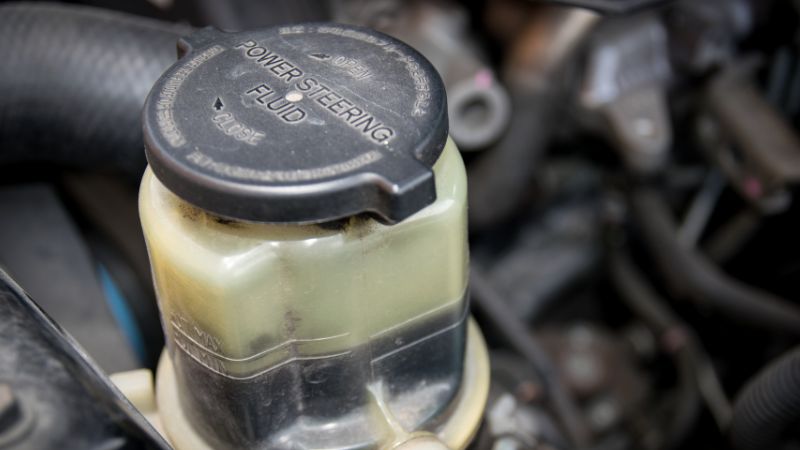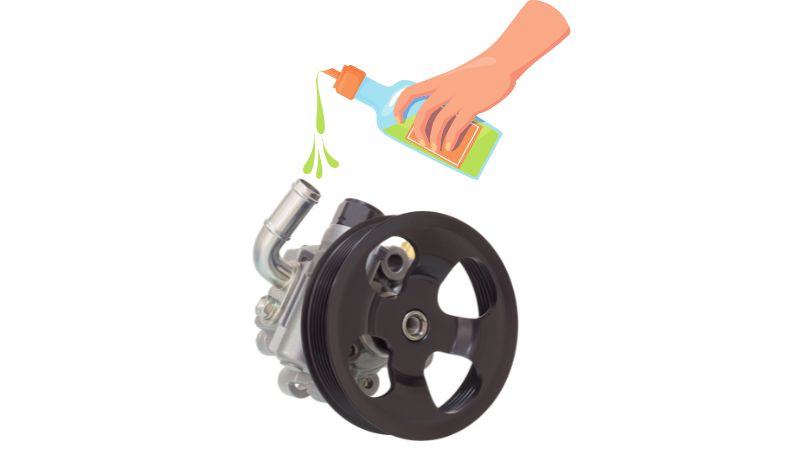Every car system needs some fluid to keep elements running smoothly. Today we will discuss a topic that is very important for your safety. Power steering fluid is an essential part of the auto steering system. It allows you to drive or move quickly. This fluid helps to transfer power in modern cars with power steering.
But it’s important to know how long does power steering fluid lasts to keep your vehicle performing at its best. Power steering fluid generally ensures that servo pumps, valves, hoses, and pistons work optimally. That’s why you should monitor and flush your vehicle’s power steering fluid in time. And when necessary, you need to replace it.
Related: Power Steering Fluid vs Hydraulic Fluid: Any Difference?
How Long Does Power Steering Fluid Last?
Accordingly, a power steering fluid is your vehicle’s most crucial hydraulic fluid. Additionally, this fluid is needed to reduce wear and tear on your steering system’s moving parts. Also, power steering fluid minimizes the power required to turn the wheels.
Some people change their power steering fluid when they have problems. However changing your fluid depends on your vehicle, type of use, type of fluid, and fluid composition.
After opening it, if you can store it correctly, your power steering fluid will last 2 to 3 years. Usually, the life of the power steering fluid depends on sealing and storage. However, if you don’t open your liquid, it will last 3 to 4 years. If you aren’t correctly sealed, steering fluid does not last a year. Because the liquid is heavily contaminated or breaks down for some reason.

How Often To Change Power Steering Fluids?
The question “When to change power steering fluid” is less easy to answer than gasoline or oil. Some sources say you should change your power steering fluid every 50,000 to 75,000 miles. And others say it should be changed every two years.
In contrast, experts say you should change your power steering fluid every 80,000 miles or every two years. The reality is there’s no correct answer, and even automakers vary in their opinions. Nevertheless, like engine oil, you don’t need to change this fluid very often.
Mainly, every vehicle has different requirements. So, to know about your car, check out your owner’s manual to determine when to change your power steering fluid. You can change it every 75,000 miles or two years. Regardless, Let’s look at some signs about when to change the power steering fluid.
Signs You Need To Change Power Steering Fluid
We’ve all encountered problems with our power steering at one time or another. If your steering needs to be more tight and manageable, pay attention. However, if you want to keep your car’s health good, you should discover the signs of the problem.
Color Change
A change in the color of the power steering fluid may mean it’s time to change your liquid, and it has begun to oxidize. The color of the power steering fluid is typically bright red. If you see it change from red to gray to black, you must change the power steering fluid.
Moreover, you need to check for particles in the liquid. Eventually, if you see something wrong, it’s time to change it with new, fresh fluid.
Bubbles In Your Power Steering Fluid
If you see bubbles in your fluid, go to the service station. It’s because, in your power steering system, you may have a potentially dangerous air leak.
Leaky Fluid
If you notice a red fluid seeping onto the floor, it’s probably your power steering fluid. Healthy power steering fluid color is a light red, although it turns amber due to a flush.
Naturally, your power steering fluid must be refilled if it leaks. This could be several things, like a hole in the pipe or an out-of-line connection. If you need more clarification, in this case, a mechanic will also need to repair and find out the source of the leak.
Steering Pump Failure
Your car’s steering pump reduces the effort you have to steer. If your steering fluid needs to be replaced, the steering pump will have to work harder.
Therefore, this can generate a lot of heat and friction. Repairing the damage that is done can be costly. You may find it more challenging to turn your steering wheel. Other signs of a failing steering pump include whining, screeching, and reddish-brown fluid under your vehicle.
Difficulty In Steering
You need to pay attention to how easy your car is to drive. Is your steering wheel hard to turn or stuttering when you ride? These signs may mean that your drive belt needs attention. The reason is that it is either overheating or out of place and needs to be tightened.
If the fluid is low, your steering wheel may feel very loose. Driving with steering problems can be dangerous for you. You can’t turn the wheel in time to avoid an accident.
Strange Sound
While turning the steering wheel, you may have a power steering problem if you hear a squealing noise. These sounds usually come from the last leg’s worn drive belt or steering pump.
Look for strange noises because it’s telling you something is wrong. A strange noise from your car usually means it’s trying to tell you something; check it out. If you experience any of these power steering symptoms, you should fix the problem as soon as possible.
Benefits Of changing Power Steering Fluid:
You may wonder when a power steering flush is essential. There are several crucial benefits of performing this service. Some necessary benefits include:
A Smooth Steering Experience
After changing your power steering fluid, you can steer your car much more smoothly. The old fluid that is full of grime can make your steering sluggish. With the new fluid, you can quickly turn or steer your car. That means you can safely drive your vehicle on the road.
Helps To Keep Your Pump Well
Changing the fluid will ensure all power steering components are working well. The power steering pump is among these components, and its replacement can be costly. In particular, if you change the fluid in time, you can prevent expensive repairs.
Removes Harmful Pollutants
Any fluid in your vehicle can accumulate dirt and debris over time. When you flush this fluid, you ride potentially dangerous contaminants from the power steering system.
Although it’s ignored, flushing the power steering fluid can improve your vehicle’s handling. Besides, it also ensures you get better handling every time you hit the road.
How To Change Power Steering Fluid Without Pump?
Adequately, if you flush your power steering fluid, you can reduce power steering pump noise. Let’s learn how to change the power steering fluid without a pump with easy steps:
Step 1.
Jack your vehicle to make the job easier. Now open the hood, locate the power steering reservoir, and open the cap. Then, suck out the old fluid through the oil suction pump.
Step 2.
Remove the reservoir hose faucets and take them out to clean with carb cleaner.
Step 3.
Draining an old fluid, adding new liquid, and steering to lock the wheel lock. This will suck new fluid from the reservoir and expel old fluid from the small hose.
Step 4.
Do this procedure several times until new fluid emerges from the small-diameter hose.
Step 5.
Connect the discharge hose to the reservoir and add fluid if necessary.
Step 6.
Start the engine and turn the wheel lock to lock to flush out any bubbles in the system. If necessary, please add some fluid.
Step 7.
Finally, lower the jack and take your car for a 10-minute drive. Then recheck the fluid level.
How To Check Power Steering Fluid?
To check your power steering fluid, you can follow our simple steps:
Step 1.
Open your vehicle hood and find out the power steering fluid reservoir. It will probably have a picture of a steering wheel on the cap or say, “Power steering.”
Step 2.
Check the fluid level through the reservoir or dipstick. You will find a dipstick inside if you can’t see the reservoir. Therefore, you can see the two lines such as minimum and maximum.
Step 3.
Usually, if your fluid level is between these lines, you don’t need to add more fluid.
Step 4.
You need to add more if you can see it’s under the minimum level. Please be careful so that it can’t cross the Maximum line. Fluid expands during use, so it needs extra space.
Step 5.
Make sure you use the proper type of power steering fluid. Generally, before using a power steering fluid, check your owner’s manual and use the recommended fluid.
Important note:
Before using any fluid, you should check the quality of the liquid. With color, you can know about the fluid. The excellent power steering fluid looks red. Unfortunately, if you can see the brown or black color, as soon as possible, change the fluid.
FAQ (Frequently Asked Questions):
Q. How do I know if my power steering fluid needs to be changed?
Low steering fluid is one of the most common causes of steering problems. There are also more signs to know if you need to change your power starting fluid. For example, if your wheel makes a jerking sound, you have a fluid problem. Similarly, leaking is another sign that tells you you need to change the fluid.
Q. How long does power steering last in a car?
We recommend replacing your car’s power steering fluid every 50,000 miles or every two years. Subsequently, the power steering fluid lasts long, so you don’t need to change it more often.

Final Word:
In summary, pay attention to the signs of inadequate power steering fluid. It’s because it can damage your steering components significantly. At last, you need to spend vast amounts of money to replace it. That’s why you should know how long the power steering fluid lasts before experiencing any severe damage.
Though you don’t need to change your power steering fluid frequently, you must check the fluid level regularly. Here we have discussed the topic properly. We hope you are helpful. Thanks for giving the valuable time.
Read Also:
Dexron Type ATF Power Steering Fluid for Vehicle
